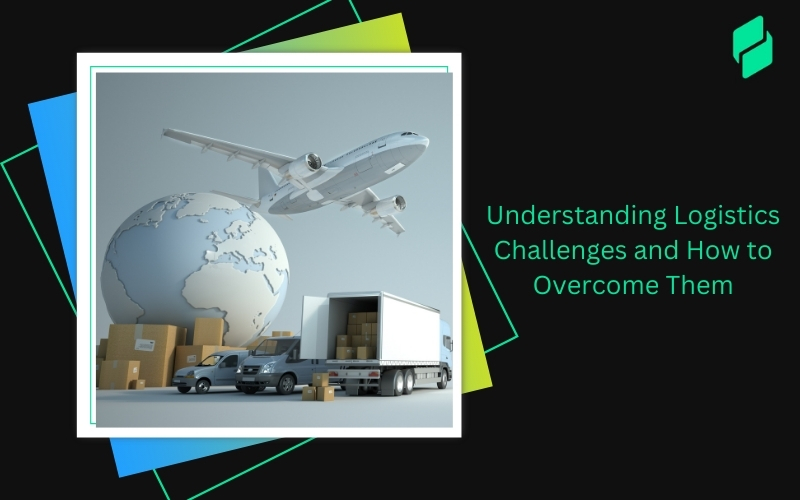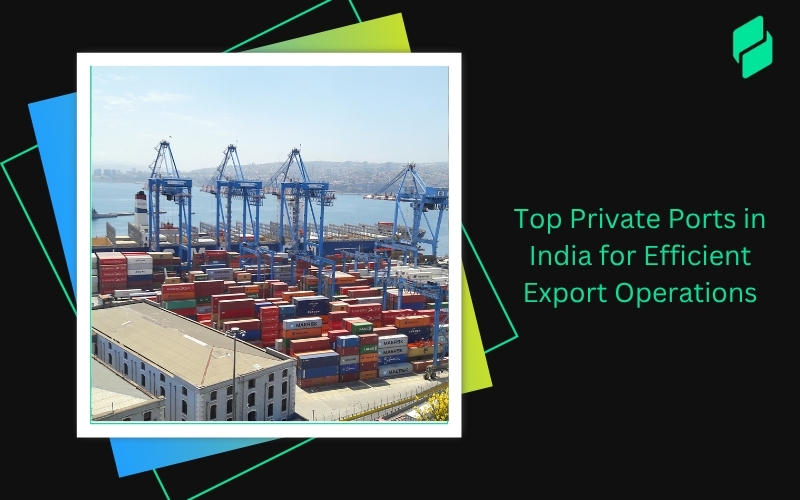Optimize your business: use unlimited savings with Pazago fulfilled now!
Get Started ->India’s import and export procedure is crucial for businesses involved in global trade. Whether you're looking to expand your business internationally or bring products into the Indian market, understanding the import process step by step is essential.
India's trade is governed by the Foreign Trade Policy (2023) and the Customs Act of 1962, which facilitate the movement of goods across borders. Additionally, trade agreements and government support schemes make international trade more accessible to businesses of all sizes.
Let's dive into the key import and export procedure steps to help streamline your operations.
Steps of the Import Procedure
Step 1: Obtain Import Export Code (IEC):
The first step in importing is obtaining an Import Export Code (IEC) from the Directorate General of Foreign Trade (DGFT). This 10-digit code is essential for customs clearance and transactions involving foreign currency.
Step 2: Legal Compliance:
Once you have your IEC, you must ensure compliance with Indian trade laws, such as the Customs Act (1962) and Foreign Trade Policy (2023). Certain goods, classified as restricted or canalized, may require additional permits.
Step 3: Import Documentation Process:
Having the right documents is essential to ensure smooth customs clearance. The Bill of Entry is a crucial document that lists the goods and their value. You also need the Commercial Invoice, which details the buyer, seller, quantity, and price of goods.
The Certificate of Origin is another essential document that verifies where the goods are manufactured. This document can significantly impact the duties or taxes imposed, especially if there are preferential trade agreements.
Step 4: Customs Clearance and Import Duties:
Customs duties are a key part of the import process. For each shipment, customs officials inspect the goods and ensure compliance with regulations. Based on the goods' HS Code classification, duties such as Basic Customs Duty (BCD), Anti-Dumping Duty, and IGST will be levied.
Certain goods may attract Anti-Dumping Duties if imported at prices lower than their fair market value, which could harm local industries. Having accurate documentation helps avoid unnecessary delays and fines.
Step 5: Goods Release:
Once customs officials have inspected the goods and paid all the applicable duties, a “pass-out order” is issued. This order permits the release of the goods from the port or warehouse.
Common issues like misclassified goods, missing paperwork, or incorrect valuations can delay this process, but with proper preparation, you can avoid such setbacks.
Also Read: Import And Export Services: Basic Guidelines And Procedures
Steps of the Export Procedure
Step 1: Obtain Import Export Code (IEC):
- Just like imports, you must obtain an IEC to export goods from India. Without this code, you cannot process any shipments abroad.
Step 2: Certificates of Origin:
- You'll need to register with the Indian Chamber of Commerce (ICC) to obtain a Non-Preferential Certificate of Origin certifying the origin of your goods.
Step 3: Export Documentation:
- The Shipping Bill is the primary document for exporting goods. Other essential documents include the Commercial Invoice, Packing List, and any necessary export licenses.
Step 4: Customs Clearance:
- After you submit your shipping documents, the goods are inspected by customs officials. If everything is in order, customs will approve the shipment for export.
Also Read: ERP for Import Export Software Solutions
Key Documentation for Import and Export

Before discussing the specific documents needed for import and export, it’s essential to understand why proper documentation is crucial. Every step in the import and export procedure requires precision, as missing or incorrect paperwork can result in delays, financial penalties, or even legal trouble.
These documents ensure smooth customs clearance and play a vital role in calculating taxes and duties, verifying the origin of goods, and complying with government regulations. Having the right paperwork ensures that your global trade operations run efficiently.
Now, let’s break down the key documents required for imports and exports:
HS Code Classification
Importance of HS Codes in Global Trade
The Harmonized System (HS) of tariff codes standardizes product classification globally, ensuring consistency across 180 countries. Customs use HS codes to determine the duties, taxes, and any restrictions applicable to the goods. The first six digits of the HS code are universal, while the last digits vary by country.
For businesses, using accurate HS codes is crucial as errors can lead to shipment delays, fines, or penalties and can also affect trade agreements and preferential tariffs, such as those under free trade agreements (FTAs).
How to Classify Products Using HS Codes
Product classification using HS codes involves understanding the description of goods, their components, and their intended use. Businesses often use online databases or consult customs agents to match their products with the correct HS code. Misclassification can have severe consequences, including paying higher taxes or getting shipments held at customs.
For instance, machinery and electronics have specific HS code ranges (84 to 85), while food items and textiles fall under different codes. Each HS code determines how customs treat the product regarding duties and restrictions.
Examples of HS Code Use
Let’s take electronics as an example. Mobile phones fall under HS Code 8517, and this classification influences both import duty rates and eligibility for tariff concessions under specific trade agreements.
Comparatively, textiles such as cotton garments are classified under HS Code 6203, which has different duties, mainly if imported from countries with which India has preferential trade agreements. Accurate HS code classification is key to benefiting from reduced duties under schemes like the ASEAN-India FTA.
Logistics and Compliance in International Trade

Indian Customs Compliance Information Portal (CIP)
The Indian Customs Compliance Information Portal (CIP) is an essential tool for businesses aiming to simplify their import and export operations. It is a central platform for all information regarding the legal and procedural requirements for trading goods into and out of India.
The portal provides comprehensive details on over 12,000 tariff items and guidance on required documentation, customs duties, and regulatory compliance for imports and exports. This resource helps businesses maintain compliance while reducing delays.
Government Initiatives to Ease Trade
To simplify the import and export procedure, the Indian government has launched several initiatives aimed at reducing both the time and costs associated with cross-border trade:
- Single Window System: This system allows businesses to submit all trade-related documents electronically simultaneously, enhancing efficiency and transparency. It minimizes businesses' need to engage with multiple agencies and provides a simplified process for document approvals and customs clearance.
- 24x7 Customs Clearance: At key ports, customs operations are now available around the clock, allowing businesses to clear their goods anytime. This initiative helps minimize delays, especially for time-sensitive shipments, increasing the ease of international trade.
Also Read: Import and Export Trade: Understanding Its Impact and Strategies In India
Payment Methods in International Trade
Letter of Credit (LC)
A Letter of Credit (LC) is a common and secure payment method in international trade, where a buyer's bank guarantees payment to the seller as long as specific conditions, like submitting the correct documents (e.g., Bill of Lading, Commercial Invoice), are met.
LCs provide security to both exporters and importers, reducing the risk of non-payment. They are beneficial when trading in new markets or with unfamiliar partners.
For example, in high-value transactions such as machinery exports, LCs offer a safety net for both parties.
Documents Against Payment (DAP)
In Documents Against Payment (DAP), the seller sends the shipping and title documents through the buyer’s bank, which then releases the documents to the buyer only after payment.
This method provides the seller control over the goods until payment is received. DAP is commonly used for medium-risk transactions where the buyer and seller have an established relationship, but the seller still requires a layer of security.
For example, a seller exporting consumer goods may opt for DAP to ensure payment before the buyer takes possession of the shipment.
Why Secure Payment Methods Are Essential
Secure payment methods like LC and DAP help protect buyers and sellers from potential risks, such as non-payment or currency fluctuations. In international trade, where trust and regulations vary, these methods ensure that goods are only exchanged once the contract terms are fulfilled. They also provide legal frameworks for resolving disputes if either party defaults.
For instance, in a volatile market, an LC ensures the exporter receives payment even if the buyer’s financial situation deteriorates during shipping.
Customs House Agents (CHAs)
Role of Customs House Agents (CHAs)
Customs House Agents (CHAs) are licensed intermediaries who help businesses clear their goods through customs. CHAs handle the submission of essential documents such as the Bill of Entry, ensure compliance with customs regulations, and calculate applicable duties and taxes.
Their in-depth knowledge of customs laws makes them invaluable for businesses unfamiliar with international trade's complex procedures. CHAs also liaise with customs officers to expedite the clearance of goods, helping businesses avoid delays that can be costly in time-sensitive industries like perishable goods.
Benefits of Using CHAs
- Expertise in Customs Procedures: CHAs handle complex customs regulations and ensure proper documentation, reducing the chances of errors.
- Faster Customs Clearance: They expedite the process by liaising directly with customs officials, preventing delays in shipments.
- Ensuring Compliance: CHAs help businesses comply with evolving trade laws, avoiding penalties and fines.
- Risk Mitigation: They assist in classifying goods accurately and handling restricted items that may require special clearances.
- Cost Efficiency: By preventing delays and errors, CHAs help businesses save money on penalties and avoid storage fees at customs.
When to Hire a CHA
A CHA is particularly useful for businesses new to international trade, dealing with complex products, or managing large volumes of imports and exports. They are essential when importing restricted or regulated goods, such as pharmaceuticals or firearms, which may require additional clearances.
Businesses also hire CHAs when dealing with countries with stricter customs procedures, as these professionals can help navigate the legalities and ensure that all shipments comply with the necessary regulations, thus avoiding costly delays.
Government Schemes for Promoting Exports
Advance Authorization Scheme
The Advance Authorization Scheme aims to assist exporters by enabling them to import raw materials duty-free, provided the materials are utilized in producing goods intended for export. This initiative decreases exporters' expenses while enhancing their competitiveness in the global market by alleviating the financial strain of import duties.
One District One Product (ODOP)
India's One District One Product (ODOP) initiative enhances the export potential of distinct products from different districts nationwide. The initiative focuses on identifying unique products specific to each district and providing the essential infrastructure and marketing support to help local producers access global markets.
This approach not only highlights Indian craftsmanship but also plays a significant role in driving regional economic growth.
Market Access Initiative (MAI)
The Market Access Initiative (MAI) focuses on helping Indian exporters enter new and emerging markets. The MAI scheme provides exporters the resources to penetrate new markets, conduct trade fairs, and build relationships with overseas buyers through marketing assistance and financial support for promotional activities.
This initiative helps expand India’s export base and creates new business opportunities across various sectors.
E-Sanchit and Single Window Interface
The Indian government has introduced various initiatives to digitize the import-export process. E-Sanchit enables businesses to upload documents electronically, removing the need for physical paperwork.
At the same time, the Single Window Interface for Facilitating Trade (SWIFT) allows firms to submit trade-related documents electronically to multiple agencies at once. This reduces processing time and simplifies the compliance process, making it easier for businesses to trade internationally.
Turant Customs and Faceless Assessment
Turant Customs was introduced to enhance transparency and reduce delays in customs clearance. It digitises the entire process, automating document verification and eliminating manual intervention.
Additionally, Faceless Assessment allows customs assessments to be conducted remotely by a virtual team, ensuring quicker and impartial clearances. This has particularly helped businesses by reducing human interaction and minimising bureaucratic delays.
Special Economic Zones (SEZs)
The government has also promoted Special Economic Zones (SEZs) to boost exports. SEZ businesses receive benefits such as tax exemptions and more accessible customs procedures.
These zones encourage foreign investment and increase India's export potential. Setting up an SEZ allows businesses to streamline their export processes and reduce operational costs.
Case Study: Exporting Electronics from India
Let’s assume a fictional Indian electronics company and name it TechSpark. The company decided to expand its market by exporting mobile phones to Europe. They obtained an Import Export Code (IEC) from the Directorate General of Foreign Trade (DGFT). Next, they classified their products under the appropriate HS Code for electronics.
TechSpark faced delays due to incomplete export documentation, which was precisely an error in the Commercial Invoice and Shipping Bill.
After consulting with a Customs House Agent (CHA), they corrected their paperwork and resubmitted their documents through the Single Window Interface system for faster clearance.
Despite initial hurdles, TechSpark successfully cleared customs and used a Letter of Credit (LC) to secure payment from their European buyers.
Why Choose Pazago for Your Global Trade Operations?
Navigating the complexities of international trade can be overwhelming. That’s where Pazago steps in.
Operating across 110+ countries, Pazago is a fully managed platform that empowers businesses to simplify their import-export process, cutting costs by 20% and reducing turnaround time by 50%.
Key Features of Pazago:
- End-to-End Trade Management: From procurement to fulfillment, manage every step of your trade journey with real-time tracking, notifications, and seamless communication across all parties involved.
- Efficient Documentation: Digitally manage critical trade documents like invoices, certificates of origin, and customs forms. Create, review, approve, and share documents all in one platform.
- Integrated Payments & Forex Solutions: Receive international payments faster with priority clearance and low Forex rates through partnerships with trusted financial institutions. Say goodbye to transaction limits and delays.
- Streamlined Logistics: Track shipments from 180+ shipping companies worldwide with real-time updates. Pazago’s partnerships with top shipping lines ensure reliable ocean and inland transportation delivery.
- Customs Clearance & Insurance: Simplify customs regulations and secure your shipments with digital insurance solutions, ensuring smooth trade operations without paperwork hassles.
Pazago’s comprehensive platform centralises all trade operations, allowing businesses to scale globally while mitigating risks and saving valuable time. Discover how Pazago can transform your supply chain management here.


.png)








